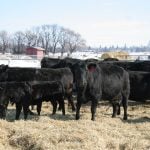New cicer milkvetch variety
Agriculture Canada scientists at the Lethridge Research Centre have dramatically improved yield potential for cicer milkvetch with a new variety that makes the crop “an ideal pasture legume,” said forage researcher Surya Acharya.
In the establishment year during preliminary trials at Lethbridge, yields for the new variety were twice those of Oxley, the current variety, and averaged 150 percent more over the first three years, he said.
It now enters co-op trials and, if all goes well, will be released in 2000. Seed could be commercially available one or two years later.
Read Also

VIDEO: Ag in Motion documentary launches second season
The second season of the the Western Producer’s documentary series about Ag in Motion launched Oct. 8.
“This variety makes cicer milkvetch an ideal pasture legume,” he said. “It has always been a neglected legume with good potential, especially for grazing and we’re now reaching that potential.”
The crop does not lend itself to hay production because it is difficult to dry in the swath.
Oxley is difficult to establish because the seeds are slow to germinate and seedlings grow slowly, he said. The as yet unnamed new variety has been bred specifically to eliminate the seedling vigor problem, and retains all the desirable qualities of Oxley.
The new variety has its best potential as a pasture legume, he said. “This legume is long-lived, nonbloating, grows well, has no serious diseases or insect pests, and pocket gophers leave it alone,” said Acharya. “Cattle readily graze cicer milkvetch, and with sheep it is more palatable than alfalfa, especially when the crop is in mature stage.”
In contrast to alfalfa in a pasture mixture, the cicer milkvetch component tends to increase as the stand gets older. After flowering and seedset, the top leaves and stems continue to grow and produce lush green high quality forage. Unlike alfalfa, cicer milkvetch stems are hollow and are not as tough when mature.
The legume yields five to six tonnes of dry matter per acre, about the same as alfalfa in a two-cut system, but less than alfalfa in a three-cut system, he said.
The forage yield is about the same whether it is cut or grazed once or twice a year.
“It is possible we need a special inoculant to maximize productivity of cicer milkvetch,” said Acharya. “The available inoculants were developed for larger southern markets and may not be ideally suited to our cool soils.”
Seeding methods are especially important for cicer milkvetch because of its slow growth at seedling stage.
– Agriculture Canada
Here are some guidelines for seeding forages that allow the establishment of vigorous stands of cicer milkvetch in one season.
- Use freshly inoculated, newly scarified seed.
- Seed cicer milkvetch alone or with a grass. Do not use a companion crop.
- Seed shallow into a clean, firm seedbed.
- At seeding, fertilize the crop according to soil test and recommendations.
- Mow the crop when it is 25-30 centimetres high. This is essential to ensure the grass does not take over the stand before the cicer milkvetch is established. It also cleans out annual weeds before they can set seed, and encourages the cicer milkvetch to branch and spread.
Yucca plant for ruminants
An extract from yucca plants can help control undesirable parasites and improve nitrogen metabolism in the rumen, according to early results from an ongoing project at the Agriculture Canada Lethbridge Research Centre.
The results show good potential for cattle producers, said Tim McAllister, a researcher on the project along with K-J Cheng and Lyle Rode.
“Yucca extract allows for better utilization of nitrogen by the animal. That means less nitrogen excretion and more nutrients available for energy,” McAllister said.
Researchers are interested in yucca saponin, a compound with potential to act on rumen micro-organisms. Commercial use of the extract is being investigated by Proform Feeds of Chilliwack, B.C., one of many industry partners supporting research at the centre.
To finance the project, industry funds from Proform Feeds were matched with government money through Agriculture Canada’s Matching Investment Initiative.
The initiative was started in 1994 to promote technology transfer and greater involvement of industry in research funding and priority setting. It is based on the assumption that a simple way to determine the potential of any research is to determine how much money others are willing to invest in it. If industry is prepared to invest, government can more easily justify matching the contribution dollar for dollar.
In early experiments with sheep, yucca extract added to the diet on a daily basis significantly lowered the pH of ruminal fluid. Protozoal populations were also significantly lower, though not eliminated from the rumen. The anti-protozoal effect appeared uniform when applied on a daily basis.
Ammonia concentrations were also lower, and the yucca extract did not appear to disrupt the concentration of free amino acids or the digestibility of the diet. Artificial rumen experiments confirmed the sheep results.
“These results suggest that yucca extract can favorably alter nitrogen metabolism in the rumen under certain conditions,” said McAllister.
The ongoing yucca saponin project will look at further potential for the extract, said McAllister. “We’ll continue to evaluate the ability of yucca saponins to reduce protozoal numbers in the rumen, improve ruminal protein metabolism, and favorably alter rumen microbial populations.”
– Agriculture Canada
No-till requires adequate fertilizer
Producers who adopt no-tillage management must ensure nitrogen fertility is adequate. If not, yields and possibly grain protein will suffer.
A long-term crop rotation experiment was initiated on a fertile black clay soil at Indian Head, Sask., in 1957. After the system changed from conventional tillage to direct seeding in 1990, yields of wheat grown on chemical fallow were far superior on a system that got nitrogen and phosphorus fertilizer compared to an unfertilized system.
In the previous 34 years, differences in yield due to fertilizer had been small to non-existent.
Why the sudden yield drop when converted to no-till management? Study continues, but Agriculture Canada researchers Con Campbell and Guy Lafond report it seems reasonable to speculate that reduced nitrogen availability in the no-till unfertilized system is the main reason.
When the land was conventionally tilled, enough nitrogen was mineralized from the soil organic matter during the year of fallow that production was rarely limited by available nitrogen in this fertile soil.
However, this is like going to the bank and drawing down your capital. Sooner or later the fund (of nutrients) will be depleted.
Laboratory analyses prove this. The ability of soil in the fallow-wheat rotation to supply nitrogen to the crop, just from mineralization of the organic matter in the soil, is now only half of that in the best managed systems (e.g., continuous wheat receiving nitrogen and phosphorus annually based on a soil test.)
Further compounding the problem is the fact that no-tillage probably increases soil water storage over winter, and maintains surface crop residues. The combination of extra water, extra residues, and presence of nitrate-nitrogen will facilitate loss of nitrogen from the soil and into the air, via a process called denitrification.
Nitrogen is disappearing from both fertilized and unfertilized systems, but the latter can ill-afford losses because it gets no added fertilizer and has reduced ability to mineralize soil nitrogen.
Another weakness of the unfertilized no-till system is that without tillage, the amount of nitrogen the soil will mineralize during the fallow period is reduced.
Results show that although yield losses due to poor fertilizer practices combined with frequent fallow might take a while to become evident, adoption of no-till farming will hasten the visibility of negative effects.
In less fertile soils, researchers expect the negative effects will become apparent much earlier.
Farmers who adopt no-till direct seeding should soil test and apply appropriate rates of fertilizer or grow nitrogen-fixing legumes in their rotations.
– Agriculture Canada














